The submarine in Jules Verne’s novel Twenty Thousand Leagues Under the Sea is one of the most amazing settings in all of literature. Let’s explore it.
Before we do, I’ll invite you to write and submit a short story to an anthology I’m co-editing along with the esteemed Kelly A. Harmon of Pole to Pole Publishing. Twenty Thousand Leagues Remembered is intended for release on June 20, 2020, the 150th anniversary of Verne’s masterwork. Click here for details about submitting your story.

As a degreed naval architect and former submariner, I could write many posts about the design of the Nautilus. You can read this book or this one, or peruse this website for more information like that. My purpose today is to explore this submarine as a literary setting.
Before the publication of Verne’s novel, submarines were tiny and dangerous; they could only stay submerged a short time. In the public’s mind they were curiosities, odd little experimental toys. Moreover, electricity was new—a phenomenon with known, but unrealized potential.
At a stroke, Verne astounded readers with a submarine like they’d never imagined. He gave them a glimpse through the veil of the future. The Nautilus was far bigger than any real submarine to date, nearly as big as the naval ironclad surface ships of the time. With a maximum speed of fifty knots, the Nautilus could outrace anything at sea. Moreover, it could dive into any deep-sea trench and only needed to surface once a day for air.

At a time when people lit their homes with whale oil, cooked with wood, and powered ships with coal, Verne sparked their imaginations by giving them an all-electric vessel. “Electricity” was then still almost magical, and Nemo had tamed it for lighting, cooking, and propelling his vessel.
Verne alarmed his readers with a horrible new weapon of war. No longer would the seas be safe when an unseen danger could rise from the depths and cleave ships in two. It’s how the book began, with mariners terrified of a ‘sea monster’ that struck without warning.

Yet the Nautilus had another side, as Pierre Aronnax learned. It was a civilized vessel, with a vast library and a relaxing parlor or salon with paintings, busts, and display cases. Yes, even a pipe organ. Large portals opened to provide a window to the sea, making this submarine a vessel of exploration, too.
But Verne’s surprises didn’t end there. For the sailors of the Nautilus, the sea wasn’t merely their workplace. It was home. Unlike all previous humans, they lived their lives in the ocean, never making land, eating only seafood, and being buried in the depths.
For Conseil, Pierre Aronnax, and especially Ned Land, the Nautilus was also an iron prison from which escape seemed impossible. Before the phrase ‘gilded cage’ came in vogue, Verne trapped his characters within one. The scenes played out between metal bulkheads with characters caught in an odd dichotomy. Freer than anyone else to explore the vast oceans, they could not pass beyond the Nautilus’ steel hull. Were they guests, or prisoners, or both?
The Nautilus was, and remains, unique. Some literary scholars consider it a character in its own right. I don’t go that far, but this submarine makes for a remarkable setting. Many novels since have been set aboard submarines, but we must measure all fictional subs against the standard of the Nautilus.
That concludes our tour. Watch your step on the ladder and don’t hit your head on the hatchway. Please exit quickly; if Captain Nemo found out I’d brought you aboard, I’m not sure what he’d do to—
Poseidon’s Scribe
